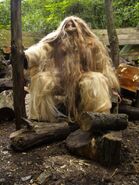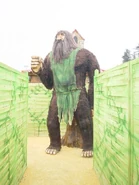The Basajaun or Basaxaun, "Lord of the Woods", is a hairy and generally peaceful giant originating from Basque and Navarre mythology. Basajaunak were thought to build megaliths, and keep the secret to various skills and technological advancements humans learnt through trickery.
Description[]
Basajaunak are huge humanoids, 9 to 16 feet tall, furred all over, sporting a beard and long hair, sometimes reaching their feet. The Basajaun also had a female counterpart, the Basandere, which lacked the beard.
Some versions of the myth claim their soles were circular, much like a cow's hooves.
Myth[]
Basajaunak were usually shepherds, often seen taking care of huge flocks of sheep, whistling and shouting to warn humans shepherds of incoming storms or wolf packs, expecting a piece of bread in return, which would be collected while they slept.
Basajaunak, much like the jentilak, made use of their strength to build megaliths, dolmens and cromlechs, and knew agriculture, music, ironworking, carpentry, arquitecture and similar technologies long before humans did.
Basajaunak were believed to inhabit Ataun and Gorea's forests in the Basque country and the Irati jungle in Navarre.
Martin Txiki[]
Martin Txiki, Saint Martin Txiki or Saint Martinico was a human trickster, known for stealing the basajaunak's knowledge through luck and ingenuity.
Agriculture and Music[]
Basajaunak were known to keep great piles of wheat grain obtained from agriculure, but they didn't share any with humans. Thus, Martin put on huge, loose boots and went up to meet a Basajaun and made a bet: whoever managed to jump higher above the pile would keep the pile of wheat. Naturally, the Basajaun lost, and Martin fell into the pile... collecting a multitude of grains into his boots.
Having collected the seeds, mankind only lacked the knowledge to use them, which Martin obtained by eavesdroppingon a singing Bajaun, learning not only when to plant a multitude of crops, including the recently obtained wheat, but also learning about music for the first time.
Saws, metalworking and mill axles[]
Surprised by how Martin had managed to steal the knowledge of agriculture from them, the Basajaunak barred Martin from coming near, so he sent a kid to let them know that he had finally worked out how to manufacture axes. Even more surprised, the Basajaunak theorized on how he might have figured it out, and a Basajaun commented that "he might have drawn inspiration from an oak's leaves", a comment which the kid took note of and reported back to Martin, thus actually learning how to make saws.
The same trick was used to steal a variety of ironworking tricks, as well as the best material for making mill axles, before a Basajaun learnt of this trick and went down to Martin's house at night, bending his saw's teeth in anger and revenge, but accidentally improving upon Martin's design.
Origin[]
The Basajaun myth is hypothesized to have its roots in human coexistence with Neanderthals, both due to the knowledge they had when they first met humans and the hairy descriptions both Neanderthals and Bajaunak share.
[]
- The Basajarau, an Aragonese variant of this myth
- The Jentilak, another giant of Basque mythology, although way more aggressive.
- Bigfoot, with which Basajaun are sometimes compared as being the spanish equivalent.
- Prometheus, another trickster of Greek mythology who, like Martin Txiki, stole knowledge to mankind's benefit.






